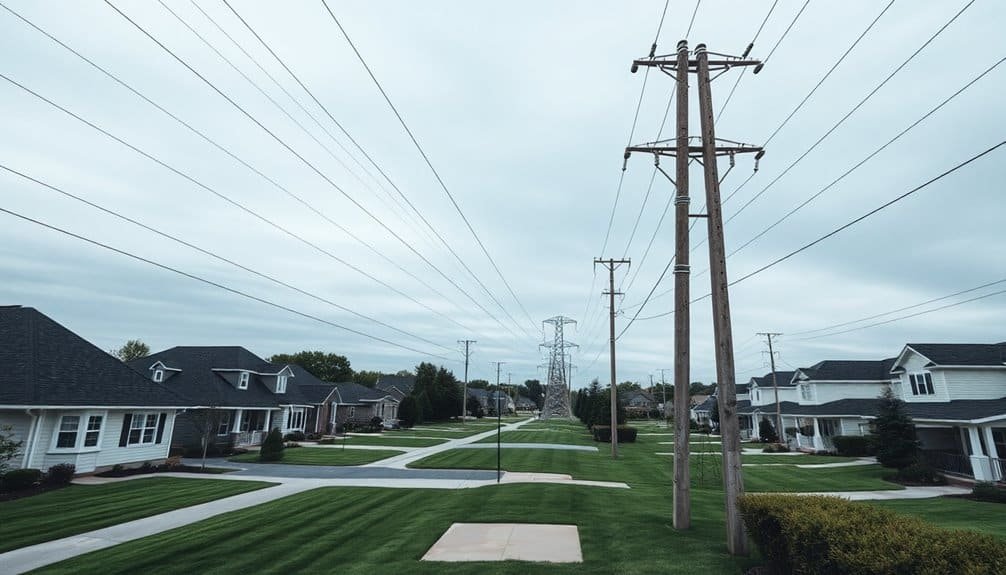Is It Safe to Live Near Power Lines?
Living near high-voltage power lines may increase health risks, particularly childhood leukemia, with studies indicating a 69% higher risk for children within 200 meters. While electric fields can reach up to 5 kV/m, magnetic fields generally remain below 40 µT.
Most cancer types show inconsistent links to EMF exposure, but regulatory guidelines suggest maintaining a distance of 20 to 50 feet based on voltage levels. Understanding the associated risks and recommended precautions is crucial for those living near these lines.
Disclaimer: As an affiliate, I may collect a share of sales from the links on this page.
Health Risks Associated With Power Lines

While living near power lines raises health concerns, research provides mixed evidence about the risks involved.
Studies suggest no consistent link between living near power lines and increased cancer risk, particularly for most types of cancer. However, some research indicates a potential association between high electromagnetic field (EMF) exposure and childhood leukemia, especially for those within 200 meters. Limited findings show risks may decrease beyond 600 meters. The biological mechanisms behind EMF exposure effects remain unclear. Epidemiologic studies report associations between health effects and electric/magnetic field exposure, but challenges arise in determining individual exposure due to multiple sources. Regular monitoring of EMF exposure levels can help identify potential risks for those living near power lines.
Because thorough, extensive studies are needed, public concern continues despite the lack of strong evidence supporting significant health risks.
Exposure Levels and Their Impact
As you consider living near power lines, it’s important to understand the varying exposure levels to electromagnetic fields (EMF) and their potential impact on health.
Electric fields can measure up to 5 kV/m near high-voltage lines, decreasing rapidly with distance. Magnetic field exposure usually stays below 40 µT in close proximity. While average daily exposure is much lower, international guidelines suggest precautionary measures for vulnerable groups like children. Natural sources of EMF include phenomena like thunderstorms, which can also influence local electromagnetic conditions. Federal standards don’t exist in the U.S., but organizations like WHO and ICNIRP recommend limits to prevent adverse health effects. Additionally, health risks associated with prolonged EMF exposure can include symptoms like fatigue and irritability.
Understanding these levels helps you make informed decisions about your living environment.
Scientific Studies on Power Line Proximity

Research into the health effects of living near power lines has sparked significant interest, particularly regarding cancer risks. Studies indicate a potential link between proximity and increased childhood leukemia or brain tumors.
One key finding shows children living within 200 meters face a 69% increased leukemia risk. While some studies report risk extending up to 600 meters, many don’t consistently support a strong association.
Additionally, limited connections between high electromagnetic fields and cancer risk exist. However, biological mechanisms remain poorly understood, complicating assessments. EMFs consist of electric fields and magnetic fields, which can raise concerns about health impacts.
More nuanced research is essential for clarifying these health implications further.
Regulatory Guidelines and Safety Standards
Understanding regulatory guidelines and safety standards is essential for anyone working near power lines. OSHA mandates a minimum clearance of 20 feet from power lines up to 350 kV during operations. For higher voltages, a clearance of at least 50 feet is recommended.
Equipment operations closer than these distances are prohibited unless specific safety measures are in place. Utility companies must install insulating devices when feasible. Additionally, having trained spotters to monitor equipment movements is critical.
Always consider environmental factors influencing safe distances, like humidity and wind, and use visual aids to help maintain proper clearance during operations.
Community Perception and Public Awareness

How do communities perceive the presence of power lines?
Overall, many people express hesitation about living near high-voltage power lines due to concerns about potential health risks, particularly related to electromagnetic fields. Although evidence about these risks is mixed, fears persist.
Additionally, residents often find power lines visually unappealing, contributing to negative perceptions. Environmental issues, including disruptions to local wildlife and biodiversity, further fuel apprehension.
The “Not In My Back Yard” phenomenon illustrates strong local opposition.
Enhancing public awareness through education and engagement can help address misconceptions, promoting a better understanding of both safety and potential benefits associated with power line infrastructure.
Frequently Asked Questions
How Can I Test EMF Levels in My Home?
To test EMF levels in your home, get a certified EMF meter, like a Trifield or Meterk. Scan areas where devices operate, and identify high-emission spots for further assessment and mitigation. Regular checks are key!
Are There Specific Power Line Types Associated With Higher Risks?
Yes, extremely high-voltage (EHV) lines are associated with greater health risks due to stronger electrostatic effects. High-voltage transmission lines raise concerns about increased cancer risks, particularly childhood leukemia, compared to lower voltage distribution lines.
What Precautions Should Children Take Near Power Lines?
When kids play outside, remind them to steer clear of power lines. Teach them never to retrieve kites or toys from wires and highlight that safety first means fun later—always play safely and smartly.
How Do Power Lines Impact Property Values?
Power lines can affect property values mainly due to perceived health risks and aesthetic concerns. You might find that proximity to high-voltage lines decreases appeal, especially in competitive markets, but effects often diminish over time.
Can Animals Also Be Affected by Living Near Power Lines?
Power lines don’t just hover like ominous giants; they can truly shake up wildlife. You’ll find animals altering their behavior, with some species avoiding areas, while others benefit from the changes in habitat.
Conclusion
Living near power lines involves balancing known and unknown health risks. Scientific studies show varying exposure levels, which can affect health outcomes. Regulatory guidelines aim to reduce these risks, but community perceptions may differ. If you choose to live near power lines, stay informed about safety standards and ongoing research. Knowledge is key to a safe living environment.






